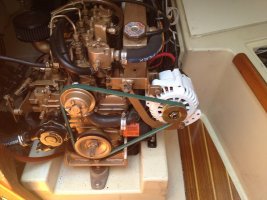Hi all,
I've searched through the forum and have found a wealth of information corresponding to the the various issues associated with Ericsons, and older sailboats in general. However, I'm a newbie to boats larger than 13ft, I've spent most of my time over the past few years capsizing Lasers in the Marina. Now, that I'm wholly addicted to being on the water, I'm going to buy my first boat...and I think an Ericson is right for us. (Partly due to a fellow on this forum who had a 32, sailed to Hawaii and back, then refit a 38 and did it all over again That said I'm in no rush and really want to make a good decision.
That said I'm in no rush and really want to make a good decision.
I'm a bit overwhelmed by the incredible repairs and updates people on this forum do to their boats, and frankly not sure I could handle some of the sort of work I see owners on this forum have done. That's not to say I'm not handy, but I'm certainly no craftsman. So it'll be important for me to find something that isn't in need of dramatic fixes right away.
Get to the point already! Ok, sorry, so this all leads me to asking if my checklist seems about right for initially assessing boats. I intend to hire a professional surveyor, but only after I find a boat that seems reasonably priced for what is being offered.
I'm looking at this one tomorrow:
http://www.boats.com/sailing-boats/1986-ericson-32-6353474/#.WbxcaRNSyLJ
Here's my checklist:
1) Hull issues? Any signs of rot, or issues with de-lamination?
2) Standing rigging, and wire corrosion, or splaying? Chainplate issues?
3) Engine Condition, Engine Hours and is there an existing maintenance log? (this will be a huge learning curve for me)
4) Age of Sails
5) Running rigging decent?
6) The head, and condition of toilet/holding tank?
7) Cosmetic condition of wood and fiberglass
8) Electronics, what works what doesn't?
9) Oh boy, I know this list is really incomplete. I need to keep reading.
Thanks in advance, and sorry if this sort of thing has been answered a million times before, or I'm posting this incorrectly in this forum.
I've searched through the forum and have found a wealth of information corresponding to the the various issues associated with Ericsons, and older sailboats in general. However, I'm a newbie to boats larger than 13ft, I've spent most of my time over the past few years capsizing Lasers in the Marina. Now, that I'm wholly addicted to being on the water, I'm going to buy my first boat...and I think an Ericson is right for us. (Partly due to a fellow on this forum who had a 32, sailed to Hawaii and back, then refit a 38 and did it all over again
I'm a bit overwhelmed by the incredible repairs and updates people on this forum do to their boats, and frankly not sure I could handle some of the sort of work I see owners on this forum have done. That's not to say I'm not handy, but I'm certainly no craftsman. So it'll be important for me to find something that isn't in need of dramatic fixes right away.
Get to the point already! Ok, sorry, so this all leads me to asking if my checklist seems about right for initially assessing boats. I intend to hire a professional surveyor, but only after I find a boat that seems reasonably priced for what is being offered.
I'm looking at this one tomorrow:
http://www.boats.com/sailing-boats/1986-ericson-32-6353474/#.WbxcaRNSyLJ
Here's my checklist:
1) Hull issues? Any signs of rot, or issues with de-lamination?
2) Standing rigging, and wire corrosion, or splaying? Chainplate issues?
3) Engine Condition, Engine Hours and is there an existing maintenance log? (this will be a huge learning curve for me)
4) Age of Sails
5) Running rigging decent?
6) The head, and condition of toilet/holding tank?
7) Cosmetic condition of wood and fiberglass
8) Electronics, what works what doesn't?
9) Oh boy, I know this list is really incomplete. I need to keep reading.
Thanks in advance, and sorry if this sort of thing has been answered a million times before, or I'm posting this incorrectly in this forum.

